Calf Start-Up Pain

Do you ever wake up in the morning with tight, painful calf muscles? For those of us who are less active, particularly through the lockdown, tightening of the calf muscles and Achilles tendons may now be a frequent occurrence when we get up in the morning. When pain is felt upon taking the first few steps in the morning, or even when standing up from a chair, but resolves after a minute or two of walking, this is called start-up pain, and is caused by contracture of the gastrocnemius muscle in the calf.
The calf has two primary muscles, the superficial gastrocnemius and the deeper soleus, which connect to the Achilles tendon. The gastrocnemius muscle attaches just above the knee, on the thigh bone whereas the soleus attaches below the knee to the shin bone. The gastrocnemius, which is usually a little slack when the knee is bent for long periods of time, will affect the position of the knee when tight, which in turn changes the ankle mobility. This tension will occur when sitting or in bed, because if the muscle is slack for an extended period, it will gradually tighten and then cause tension in the Achilles tendon. Therefore the gastrocnemius is often tightest when waking up or standing after sitting for a long time. The ankle mobility is then limited, and can’t accommodate the body moving over the foot, and consequently the heel lifts sooner, which increases the stress on the foot and ankle.
This increased stress may cause pain in:-
• the ball of the foot
• the top of the foot
• the front of the ankle
• the bottom of the heel
• the back of the heel (at the Achilles insertion point)
• the Achilles tendon
The gastrocnemius muscle is the only anatomical structure that really changes with warming up and stretching while walking, and the amplification of these changes due to reduced activity, increase the need for stretching the calf regularly to prevent various foot and ankle problems from developing.
Other ways to treat or help prevent this is massage (deep tissue or sports) or using a massage stick or foam roller.
